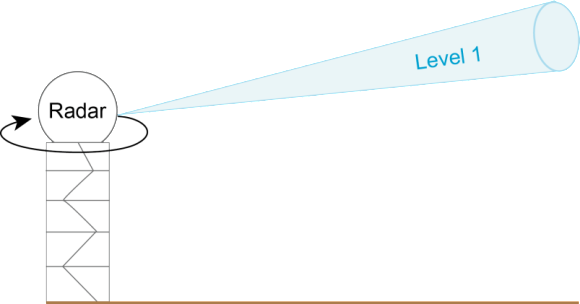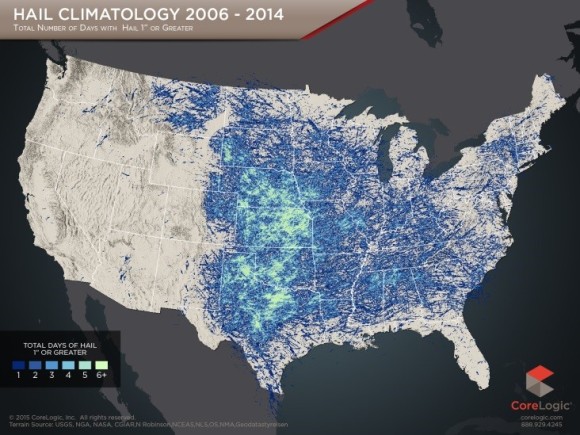This post is part of a series sponsored by CoreLogic.
Insurers that constantly face nature’s unpredictable fury must also manage claims in a way that both covers policyholder damage and maintains reserves to cover future events. In the case of hail damage claims, wide-ranging variations can occur from one year to the next. Such broad variations, coupled with the high cost of hail damage claims, requires that every insurer safeguard against claims fraud by employing the most effective event verification and inspection processes possible. The proprietary hail verification model from CoreLogic® accomplishes exactly this. Up to four times more accurate than the Hail detection Algorithm-based (HDA-based) products¹, this model combines trusted hail verification methodology, weather data and on-the-ground information to establish an accurate view of potential hail damage, which allows carriers to react quickly and intelligently after a hail storm occurs.
Subheading: The History of Hail Verification
The National Severe Storms Laboratory (NSSL) hail-detection algorithm (HDA) is a public-safety forecasting tool developed by the NSSL to improve National Weather Service (NWS) storm warnings². The algorithm attempts to predict whether severe hail is possible in the near future, so that the NWS can issue storm warnings to help protect lives and property.
In the past, due to the lack of options in the market, this algorithm was widely adopted and re-purposed as the default tool for forensic hail verification. Although useful in predicting whether or not hail will soon fall, it was not designed for verification, and therefore, is not sufficiently adequate for estimating the size of hail that actually impacts the ground. To fulfill the needs of the market, CoreLogic developed a state of the art, proprietary hail verification model to do exactly this—provide users with the best and most effective hail event verification possible.
| Table 1 – Design Summary | ||||
| Design Purpose | UsesNear-ground Radar Data? | Continuous Reflectivity? | Calculates Unbiased Hail Size? | |
| CoreLogic Hail Verification Model | Hail Size Verification | Yes | Yes | Yes |
| NSSL Algorithm | Storm Warnings | No | No | No |
Subheading: How does the Hail Verification Model Work
Using NWS radar data, combined with observed hail measurements, CoreLogic can effectively analyze the unique reflectivity-to-hail size relationship for each individual storm. The moment hail hits the ground is an important piece of information for most commercial users as that directly correlates with how it impacts both the property and the homeowner (Figure 1). As radar scans are only available every two to five minutes, the hail verification model from CoreLogic uses a sophisticated physics-based morphing algorithm to continuously fill in the reflectivity in data gaps every few seconds. By then analyzing the unique reflectivity-to-hail-size relationship for each storm, it produces accurate hail path and size data. Because no two hail storms are similar, this verification model adapts its analysis to each specific storm and its unique changes over time.
Figure 1 – The hail verification model from CoreLogic focuses on hail nearest to the ground.
The hail verification model was designed as a forensic verification tool. Since this model was created to verify hailfall, it is less susceptible to the problems that make the widely accepted NSSL algorithm³ unsuitable for verification. Specifically, the hail verification model:
- Uses radar data nearest to the ground, where hail impacts life and property
- Investigates the unique reflectivity-to-hail size relationship for every storm
- Eliminates hail-coverage gaps by using a sophisticated morphing algorithm to calculate continuous radar data
- Calculates unbiased hail size, since it is designed as a verification tool.
Subheading: One Size Doesn’t Fit All
It is important to note that there is no one-size-fits-all algorithm for all hail data needs, so it is best to choose the appropriate technology based on the required use. Since CoreLogic designed a proprietary hail verification model specifically to analyze the size and location of actual hailfall, industry leaders can confidently choose this model for forensic verification.
Subheading: 2006-2014 Hail Climatology
By utilizing the hail verification model, we have taken the total days of annual hail 1″ or greater across the United States from 2006-2014 and created a unique look at hail climatology for that time period. Click on the map to download your free high resolution version.
¹Product Performance Assessment. An internal study was completed by a top 5 insurance carrier claims department which showed 83 percent of policies predicted by the CoreLogic Hail Verification Model to have ≥ 2.5″ hailstone diameter filed and had paid claim, but only 20 percent of competitor policies with ≥2.5″ hailstone diameter had a filed and paid claim. The competitor algorithm overestimated the hailstone diameter while the CoreLogic Hail Verification Model was more realistic.
²Witt, A., M.D. Eilts, G.J. Stumpf, J.T . Johnson, E.D. Mitchell, and K.W. Thomas, 1998a: An enhanced Hail Detection Algorithm for the WSR-88D. Wea. Forecasting, 13, 286-303.
³http://www.nssl.noaa.gov/research/hail/
For more information, please visit: http://www.corelogic.com/solutions/weather-verification-services.aspx?WT.mc_id=insj_150930_ZuUX8
Was this article valuable?
Here are more articles you may enjoy.





 Harvard Study Again Stirs the Pot on Demotech Ratings of Florida Carriers
Harvard Study Again Stirs the Pot on Demotech Ratings of Florida Carriers  Wildfires Are Upending Some of the Safest Bets on Wall Street
Wildfires Are Upending Some of the Safest Bets on Wall Street  AIG Sues Newly Launched Dellwood Insurance and Its Founders
AIG Sues Newly Launched Dellwood Insurance and Its Founders  Former MLB Player, 3 Others Charged with Staging Auto Accident in Miami
Former MLB Player, 3 Others Charged with Staging Auto Accident in Miami 

